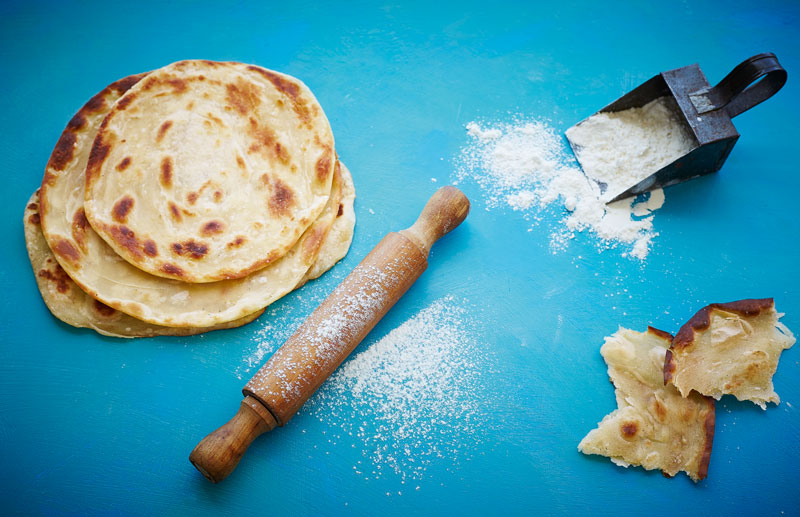“My mom taught me how to make roti and when it came to roti ingredients, she refused to skimp on the butter used for this recipe. As a little girl, I would happily sit in the centre of the kitchen floor, munching on a warm roti while watching her fry up the rest. My lips and cheeks would be covered in roti flakes and my little hands would glisten with traces of the ghee!” – Cariema Isaacs, author and chef.
ALSO TRY: Vegan Pineapple Curry with Cashews Recipe
Cariema’s Cape Malay roti recipe is an easy roti recipe for all cooks to try. This flaky roti recipe won’t take too much effort, so get cooking!
ALSO TRY: Chicken And Almond Curry With Spinach Recipe

Ingredients
- For the oil and butter mixture (ghee):
- 150 g butter
- ¾ cup (180ml) vegetable, canola or sunflower oil
- For the dough:
- 3 cups (750ml) cake flour
- ½ cup (125ml) self-raising flour
- 1 tsp (5ml) salt
- 3 tbsp (45ml) butter, at room temperature
- 1 cup (250ml) boiling water, cooled slightly
Instructions
Preparing the ghee
- Place the butter in a bowl and melt in the microwave. Once melted, stir in the oil and then set aside.
Preparing the dough
Step 1
- Place the flours, salt, butter and warm water into a mixing bowl and use the handle or back of a wooden spoon to mix the ingredients together.
- The flour will cool the water and make it easier for you to work with using your hands to mix and knead the dough.
- You should have a very sticky dough. In fact, it is ideal to have the dough moist because you can always add additional flour to get it to the consistency that you require.
- Knead the dough to form a fairly soft and pliable texture.
- Use a pastry brush to grease a bowl with the ghee before placing the warm dough in the bowl.
- Cover this with plastic wrap and set aside for at least 20–30 minutes.
Step 2
- Turn the dough out onto a well-floured surface and roll it to resemble a thick log (4–5 cm thick should do). Use a sharp knife to cut the dough into 6–8 even portions.
- In the meantime, rub a little oil onto your hands. Take the dough balls and very lightly coat them with ghee, using your hands. This assists with keeping the dough balls moist.
Step 3
- Use a rolling pin and roll out one of the dough balls into a thin circle. Try and get the layer of dough rolled out as thinly as possible.
- Dip the pastry brush into the ghee and spread it generously over the flat layer of dough.
Step 4
- Take the one end of the dough and roll it up to form a thin rope.
- Simply take the ends of the dough rope and ever so gently lift and tap it on the surface you are working on. Stretch it a little as you are tapping it against the work surface, thus making it more pliable.
- Lay the dough rope back onto the working surface.
Step 5
- We’re getting ready now to form the S-shape of the roti. Roll up the ends of the dough rope, one side clockwise and the other anticlockwise. Once they meet to form the ‘S’, fold one-half of the ‘S’ (either top or bottom) flat on top of the other.
- T he dough should now resemble a moist and round spiralling disc. Place this on a glass plate and repeat with the rest of the dough balls, using the same method as before.
- Cover the raw roti balls with plastic wrap and refrigerate for about 1 hour before frying.
Step 6
- Heat a pan or roti skillet over high to medium heat and brush the surface with ghee.
- Roll out the roti discs to about 20 cm in diameter or to the size of a smallish dinner plate.
- Place the roti in the pan and brush lightly with ghee, then flip it over after 2–3 minutes. Repeat this step once or twice or until the roti is golden and partially crispy. Remember to brush lightly with ghee every time you flip the roti.
Step 7
- Remove from the pan and lay the roti on a flat surface. Bring the edges together with your palms like you’re gently scrunching or wrinkling the roti to fluff it up.
- Place on a serving plate and serve with hot curry.
